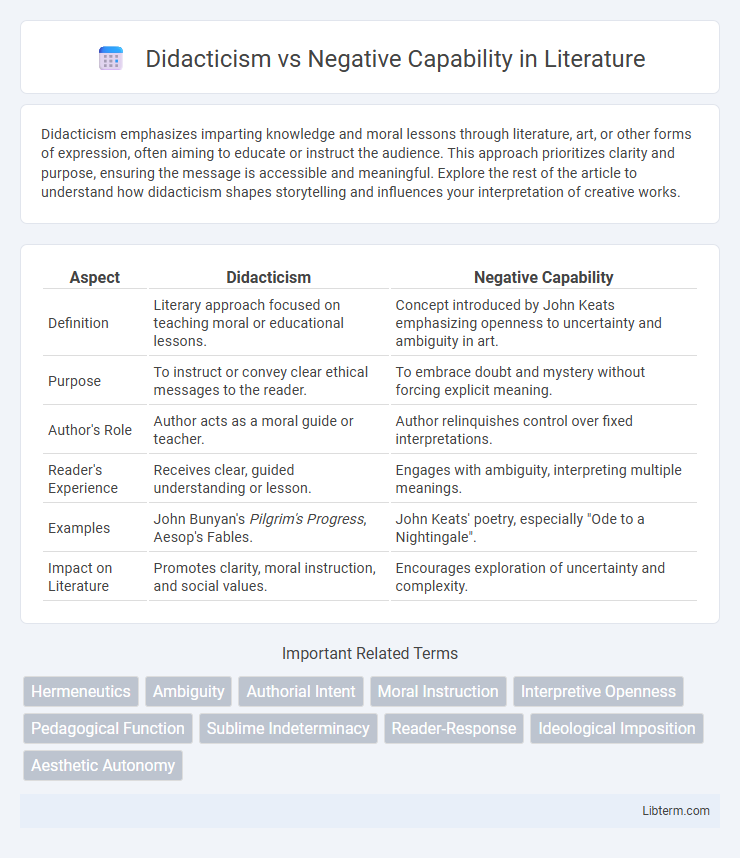Didacticism emphasizes imparting knowledge and moral lessons through literature, art, or other forms of expression, often aiming to educate or instruct the audience. This approach prioritizes clarity and purpose, ensuring the message is accessible and meaningful. Explore the rest of the article to understand how didacticism shapes storytelling and influences your interpretation of creative works.
Table of Comparison
| Aspect | Didacticism | Negative Capability |
|---|---|---|
| Definition | Literary approach focused on teaching moral or educational lessons. | Concept introduced by John Keats emphasizing openness to uncertainty and ambiguity in art. |
| Purpose | To instruct or convey clear ethical messages to the reader. | To embrace doubt and mystery without forcing explicit meaning. |
| Author's Role | Author acts as a moral guide or teacher. | Author relinquishes control over fixed interpretations. |
| Reader's Experience | Receives clear, guided understanding or lesson. | Engages with ambiguity, interpreting multiple meanings. |
| Examples | John Bunyan's Pilgrim's Progress, Aesop's Fables. | John Keats' poetry, especially "Ode to a Nightingale". |
| Impact on Literature | Promotes clarity, moral instruction, and social values. | Encourages exploration of uncertainty and complexity. |
Introduction to Didacticism and Negative Capability
Didacticism emphasizes clear, instructive communication aimed at teaching moral or practical lessons, often prioritizing explicit guidance in literature and art. Negative Capability refers to the ability to embrace uncertainty and ambiguity without the need for definitive answers, fostering creative openness and deeper emotional resonance. Understanding these concepts highlights the contrasting approaches to meaning-making: one rooted in instruction, the other in open-ended exploration.
Historical Origins and Philosophical Foundations
Didacticism traces its historical origins to classical Greek education, emphasizing moral instruction and practical knowledge through clear, purposeful texts, deeply rooted in Aristotelian ethics and rhetoric. Negative Capability, a concept coined by Romantic poet John Keats in the early 19th century, challenges fixed meanings by valuing uncertainty and embracing ambiguity, reflecting Romanticism's philosophical foundation in existential inquiry and subjective experience. These opposing approaches embody distinct epistemological traditions: didacticism seeks definitive truths and instructional clarity, while Negative Capability fosters open-ended interpretation and the acceptance of paradox.
Defining Didacticism: Purpose and Principles
Didacticism emphasizes teaching and instruction, aiming to impart moral, ethical, or practical lessons through literary or artistic works. Its core principle is clarity of message, ensuring readers derive specific knowledge or guidance directly from the content. The purpose of didacticism centers on educating audiences, often prioritizing moral or social improvement over artistic ambiguity.
Understanding Negative Capability: Keats and Beyond
Negative Capability, a concept introduced by John Keats, embraces uncertainty and ambiguity without the urge to rationalize or resolve contradictions, contrasting sharply with didacticism's emphasis on explicit moral or instructional clarity. It fosters a deeper literary and philosophical engagement by encouraging readers to dwell in doubt and complexity, facilitating richer interpretations beyond straightforward lessons. Keats' poetry exemplifies this approach, influencing modern thinkers and writers who prioritize experiential understanding over prescriptive narratives.
The Role of Ambiguity in Literature
Ambiguity in literature invites readers to engage actively with multiple interpretations, fostering a deeper emotional and intellectual connection that transcends straightforward didactic messages. Negative capability embraces uncertainty and unresolved contradictions, enriching narratives by allowing complexity and subtlety to coexist without imposing definitive conclusions. In contrast, didacticism often limits interpretive freedom by prioritizing clear moral or instructional aims, potentially reducing the richness of the literary experience.
Didacticism vs. Negative Capability: Core Contrasts
Didacticism emphasizes clear moral lessons and instructive content, guiding readers toward specific ethical or educational outcomes. Negative Capability values ambiguity, embracing uncertainty and the coexistence of contradictory ideas without the need for resolution. These core contrasts highlight didacticism's directive clarity versus negative capability's openness to interpretive multiplicity.
Impact on Literary Style and Reader Engagement
Didacticism emphasizes clear moral lessons and instructive messages, leading to a straightforward, often authoritative literary style that guides readers toward specific interpretations. Negative Capability embraces ambiguity and uncertainty, fostering an open-ended narrative style that invites readers to engage actively through personal reflection and multiple interpretations. The contrast between the two shapes reader engagement by either directing understanding with explicit themes or encouraging exploration through unresolved complexities.
Notable Authors and Representative Works
John Keats epitomizes Negative Capability through works like "Ode to a Nightingale," embracing uncertainty and ambiguity without the urge for logical resolution. In contrast, didacticism dominates the writings of authors such as John Milton, whose "Paradise Lost" conveys moral and religious instruction with clear ethical intentions. Samuel Taylor Coleridge's poetry and prose often navigate between these paradigms, reflecting both contemplative ambiguity and explicit moral reflections.
Critical Debates and Contemporary Perspectives
Didacticism emphasizes clear moral or instructional messages in literature, often inciting debates on restricting artistic freedom versus fostering social responsibility. Negative Capability champions embracing uncertainty and ambiguity, challenging traditional narrative clarity and inspiring critical discourse on the value of open-ended interpretation. Contemporary perspectives increasingly reconcile these views, recognizing the balance between purposeful messaging and the creative space for reader engagement and multiplicity of meanings.
Conclusion: Balancing Instruction and Ambivalence in Art
Art achieves its fullest impact when it balances didacticism and negative capability, blending clear instructional intent with open-ended ambiguity. Didacticism anchors the work with purposeful messages, while negative capability invites multiple interpretations and emotional depth. This equilibrium enriches meaning, encouraging both intellectual engagement and personal reflection in audiences.
Didacticism Infographic

 libterm.com
libterm.com